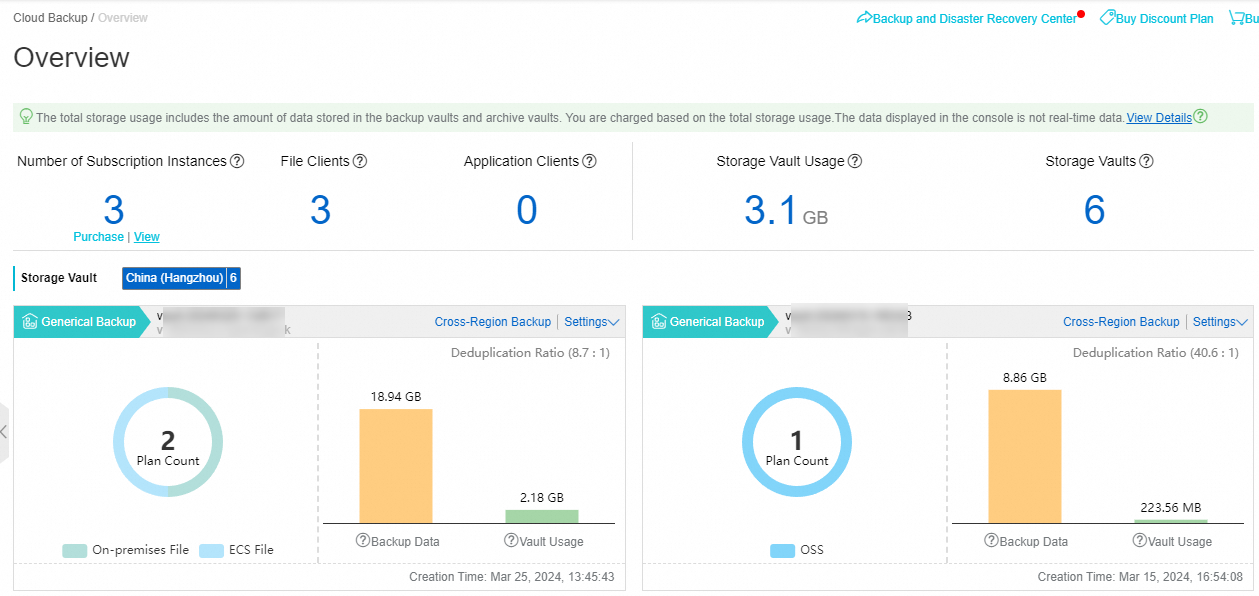Cloud Backup provides backup vaults and archive vaults to store backup data and archive data. Cloud Backup allows you to store hot data and cold data in the cloud.
Background information
You can use Cloud Backup to back up data to a cloud storage vault from Elastic Compute Service (ECS)-hosted databases, file systems, network-attached storage (NAS) devices, Object Storage Service (OSS) buckets, and self-managed data centers that store files, databases, and virtual machines (VMs). You can also perform disaster recovery and archive data based on the archive policies that you configure for the preceding resources. Backup data and archive data are stored in storage vaults on Alibaba Cloud.
Backup vaults
A backup vault is used to store your backup data. It is divided into the Standard tier and the Archive tier. After data is backed up, the backup data is first stored in the Standard tier. If you enable the automatic archiving feature, the backup data is forwarded to the Archive tier based on the specified archiving policy for long-term storage at low costs.
To maximize the redundancy of your backup data, Cloud Backup uses zone-redundant storage (ZRS)-enabled backup vaults by default in regions that support ZRS-enabled backup vaults. For regions that support only locally redundant storage (LRS)-enabled backup vaults, Cloud Backup uses LRS-enabled backup vaults. You do not need to manually select a backup vault type.
ZRS-enabled backup vaults are supported in the following regions: China (Hangzhou), China (Shanghai), China (Beijing), China (Zhangjiakou), China (Ulanqab), China (Shenzhen), China (Hong Kong), Japan (Tokyo), Singapore, Indonesia (Jakarta), and Germany (Frankfurt).
General-purpose backup vaults
General-purpose backup vaults are used to store the backup data of the following data sources: ECS files, OSS buckets, on-premises NAS file systems, File Storage NAS (NAS) file systems, large-scale file systems, on-premises files, SAP HANA databases, and VMware VMs.
Database backup vaults
Database backup vaults are used to store the backup data of MySQL, Oracle, and SQL Server databases.
OSS backup vaults (free for 30 days)
OSS backup vaults are used to store the backup data of OSS buckets that have a 30-day free trial period. After you switch to paid usage for a backup plan, the backup vault type changes to general-purpose backup vault.
Like a general-purpose backup vault, an OSS backup vault stores backup data only for the specified retention period. The backup data is automatically deleted after the retention period is reached.
If you do not switch to paid usage for a backup plan, the backup vault is retained for another 30 days after the 30-day free trial period expires. If you do not switch to paid usage within 30 days, the backup vault is deleted.
NAS backup vaults (free for 30 days)
NAS backup vaults are used to store the backup data of File Storage NAS file systems that have a 30-day free trial period. After you switch to paid usage for a backup plan, the backup vault type changes to general-purpose backup vault.
Like a general-purpose backup vault, a NAS backup vault stores backup data only for the specified retention period. The backup data is automatically deleted after the retention period is reached.
If you do not switch to paid usage for a backup plan, the backup vault is retained for another 30 days after the 30-day free trial period expires. If you do not switch to paid usage within 30 days, the backup vault is deleted.
Tablestore backup vaults
Tablestore backup vaults are used to store the backup data of Tablestore databases.
Container backup vaults
Container backup vaults are used to store the backup data of Container Service for Kubernetes (ACK) clusters.
Archive vaults
Archive vaults include LRS-enabled archive vaults and LRS-enabled cold archive vaults
LRS-enabled archive vaults
An archive vault provides highly durable data storage with low storage costs. You must restore archive data before you can access the data. The data restoration takes about 5 minutes, and you are charged for the data retrieval. LRS-enabled archive vaults are suitable for data that needs to be stored for a long period of time, such as archival data, medical images, scientific materials, and video footage.
LRS-enabled cold archive vaults
A cold archive vault provides highly durable data storage with the lowest storage costs among all storage vault types. You must restore archive data before you can access the data. The time required to restore archive data depends on the data size and the restoration mode. You are charged for the data retrieval. LRS-enabled cold archive vaults are ideal for storing cold data over an ultra-long period of time. Such data includes the data that must be retained for an extended period of time due to compliance requirements, raw data that is accumulated over an extended period of time in the big data and AI fields, retained media resources in the film and television industries, and archived videos in the online education industry.
Billing of storage vaults
Fees are incurred when you use storage vaults. For more information, see Billing methods and billable items.
You can use resource plans to reduce storage costs. For more information, see Purchase resource plans.
View storage vaults
Method 1: View storage vaults on the Storage Vaults page
Log on to the Cloud Backup console.
In the top navigation bar, select a region.
In the left-side navigation pane, click Storage Vaults.
The Storage Vaults page displays all backup vaults and archive vaults. You can view the following information about each storage vault: name, ID, type, status, creation time, the amount of source data, the amount of data stored in the storage vault, and the number of backup plans. For more information about storage vaults, see Storage vault types.

Method 2: View storage vaults on the Overview page of the Cloud Backup console
